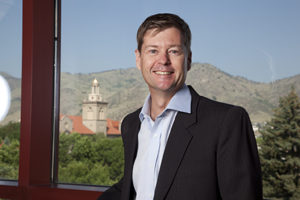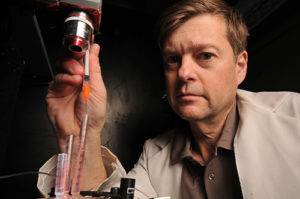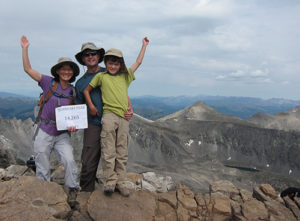2014 Distinguished Lecture Series: David Marr
My Dark Path to the Bio Side
December 3, 2014, 4 p.m.
Student Center Ballrooms
Abstract
 During nearly 20 years at Mines, the arc of my own career has paralleled many of the changes that have occurred across campus.
During nearly 20 years at Mines, the arc of my own career has paralleled many of the changes that have occurred across campus.
Trained as a colloid/soft-matter chemical engineer, my group has studied fundamental issues in physics and transport by using applied external fields to control microscopic particles. At these length scales, the forces required for colloid manipulation are on the order of only a few piconewtons, magnitudes achievable using applied optical trapping, magnetic field, and electric field-based methods.
In this lecture I will begin by introducing the use of optical trapping-based techniques and demonstrate how one can use these within integrated microfluidic systems to overcome many of the difficulties associated with controlling assembly and directing matter at the microscale.
Building on these capabilities but with a lack of formal training in bioengineering, we have extended our interest to biological systems.
 With health care costs rising to 18 percent of the U.S. gross domestic product, the need for improved and less expensive medical tools and methods is apparent. This is an area where Mines can clearly contribute through development of improved technologies, either with methods that lead to earlier detection and better treatment, or with medical diagnostics that are smaller, less bulky, and available at the point of need.
With health care costs rising to 18 percent of the U.S. gross domestic product, the need for improved and less expensive medical tools and methods is apparent. This is an area where Mines can clearly contribute through development of improved technologies, either with methods that lead to earlier detection and better treatment, or with medical diagnostics that are smaller, less bulky, and available at the point of need.
To provide context for this discussion, I will show how such Mines research efforts can integrate within the National Institutes of Health and should remain an important need with future growth.
 Even for researchers who have been trained in other classical fields, this desire for new materials and methods has encouraged collaboration across disciplines and led to new bio-related applications. Supported by developing undergraduate and research programs across the campus, efforts in bio-related fields including biophysics, biomechanics, biomaterials and biomedical areas continue to grow at a steady pace.
Even for researchers who have been trained in other classical fields, this desire for new materials and methods has encouraged collaboration across disciplines and led to new bio-related applications. Supported by developing undergraduate and research programs across the campus, efforts in bio-related fields including biophysics, biomechanics, biomaterials and biomedical areas continue to grow at a steady pace.
As an example of where we might contribute, I will discuss one such Mines-developed technology focused on the diagnosis of blood-borne disease. In this, the testing of cell mechanical properties has shown significant potential as a reagent-free method for the differentiation of type and detection of disease. Limiting its utility, however, is the low throughput associated with the isolation and probe of individual cells in a sequential fashion. To overcome this, we demonstrate how deformation measurements of individual cells can be performed at high throughput using optical forces in microfluidic systems.
This approach may be integrated with traditional cell detection and sorting technologies, potentially lowering cost and increasing the availability of practical platforms for both laboratory and point-of-care applications.
 Biography
Biography
 Marr joined Mines in 1995 and holds a bachelor of science in chemical engineering from the University of California, Berkeley, and master’s and PhD degrees in chemical engineering from Stanford University.
Marr joined Mines in 1995 and holds a bachelor of science in chemical engineering from the University of California, Berkeley, and master’s and PhD degrees in chemical engineering from Stanford University.
Over the course of his career at Mines, Marr has received the NSF Career Award, the 2007 Dean’s Excellence Award, been an Alexander von
Humboldt Fellow and a speaker at the National Academy of Sciences Frontiers of Science program.
In addition to publications in journals including PNAS and Science, Marr has seven issued patents. He has been assistant, associate and full professor at Mines. Now beginning his fifth year as head of the Chemical and Biological Engineering Department, his administrative role is, in fact, not the dark path he refers to in his title. His intention is to reveal the nefarious motivations that have guided his career choices during the course of this lecture.
David is a devoted and obedient husband to his wife, Junko Munakata Marr, associate professor of civil and environmental engineering at Mines.
When not cooking for Junko and their 13-year-old son, Toshio, Marr enjoys hiking, soccer, skiing and using any Apple Computer product.